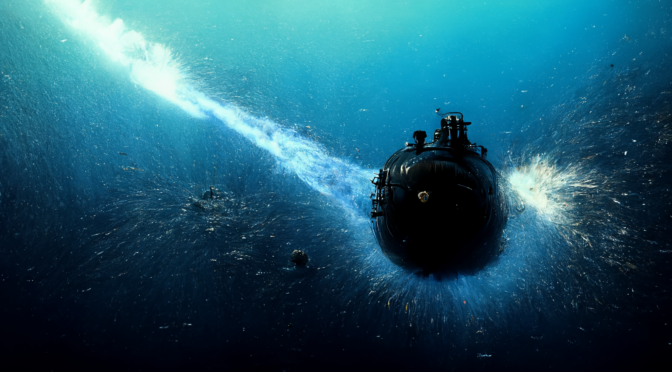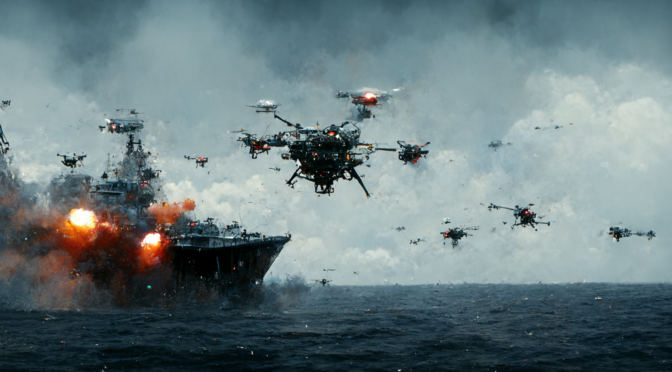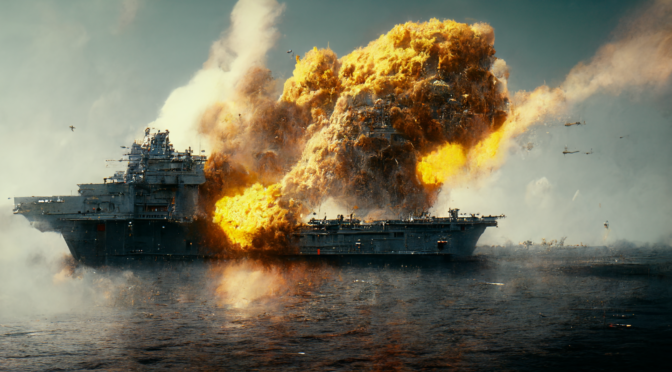By Lieutenant Jacob Rothstein, USN
Part I
“CONN, Radio, in receipt of flash message traffic. For CO’s Eyes Only. Routing to the Captain’s stateroom,” USS Seattle’s Radioman of the Watch announced over the 27MC.
“Radio, CONN, aye,” replied LTJG Michael Lee, the Officer of the Deck, without breaking concentration from his engineering study guide.
Lee looked up after hearing something that vaguely resembled a request to cross the CONN. He linked eyes with the Radioman of the Watch and nudged his head forward, granting him permission to cross the CONN. The Radioman of the Watch thanked Lee and continued to the CO’s stateroom. Lee returned to his engineering notes.
“Officer of the Deck, the navigation plot is ready for your review,” the Quartermaster of the Watch informed Lee.
Lee strolled over to the navigation plot in the back left corner of the control room for what he assumed was the 400th time this watch.
Course 082. Speed 5 KTS. Depth 60 FT. Everything checked.
Seattle was headed east after an arduous six-month Western Pacific deployment. Their hard work wasn’t over yet, though. An Operational Reactors Safeguards Examination, ORSE for short, stood between the crew and their return to homeport. ORSE, a yearly inspection designed to assess a nuclear-powered warship’s ability to respond to engineering casualties and operate in accordance with naval nuclear power procedures, takes the entire crew’s dedication to successfully complete.
Although just a three-day inspection, the preparation for ORSE begins months in advance. Nuclear operators are required to be proficient in drills, their technical knowledge, and in their ability to operate the reactor plant and associated engineering spaces.
Inside his stateroom, CDR Joseph C. McIntosh read the message handed to him by Radioman of the Watch. Growing impatient, the Radioman of the Watch’s eyes started to wander. His eyes landed upon a picture of who he presumed to be CDR McIntosh at his wedding, many years ago. McIntosh’s younger self was almost unrecognizable to the Radioman of the Watch. His eyes were now sunken, his uniform at least two sizes larger. The remaining bits of his hair, now gray.
Finally, McIntosh completed his review of the message.
“That will be all,” he said, excusing the Radioman of the Watch from his stateroom.
McIntosh’s days as the CO of the Seattle were numbered. His relief was scheduled to arrive in two weeks, just days after the Seattle’s return to port. His Change of Command Ceremony would need to be pushed back now.
“Good morning warriors, this is your Captain speaking,” McIntosh said over the 1MC from his stateroom. “I just received some exciting news.”
The crew groaned. They knew what ‘exciting’ meant in this context.
“Our country needs our help,” McIntosh continued. “We’ve been redirected back to the west. The boss needs us near Taiwan in case anything comes up. Unfortunately, this means our return to home port will be delayed at least one month. I know many of you were looking forward to reuniting with your loved ones, but duty calls. All officers, muster in the wardroom in fifteen minutes. Carry on!”
A few sailors mumbled, “Carry on, aye Sir,” in response to the CO’s message, but most were silent.
“Helm, left ten degree rudder, steady course 280,” said Lee, correctly assuming the CO would want him to turn around.
Lee and the rest of the control room made preparations to descend from periscope depth as they returned to the west.
Part II
“The good news is, we have another four weeks to prepare for ORSE,” McIntosh said to all of his officers with the exception of LTJG Lee and LTJG Vandors, his on-watch Officer of the Deck and Engineering Officer of the Watch, respectively.
“Sir, we will enter our holding area in three-zero hours,” said the NAV referencing the chart pulled up on the computer screen for the CO to see.
“Very well, NAV. ENG, what is your plan for engineering drills once we arrive?”
McIntosh’s attention was already back on ORSE.
“Excuse me, Sir. Did you say drills?” asked WEPS, interrupting the CO.
“Is that a problem, WEPS?” McIntosh asked rhetorically.
“Sir, the PLA(N) intends to execute a huge exercise in the vicinity of Taiwan. There will be a tremendous amount of warship activity.”
WEPS had a habit of answering rhetorical questions.
“Do you have a recommendation for me WEPS? Or did you just want everyone to know that you read the news this morning?”
“Sir, I recommend we do not conduct drills while in our hold box based on our proximity to PLA(N) assets.”
“Very well, WEPS. I understand your recommendation and do not concur with it,” McIntosh said as he scanned the wardroom. “Does anyone else think drills are a bad idea?”
Blank stares followed.
“This back and forth with China over Taiwan has gone on for ages. I’ll be damned if you think I am going to let the crew sit in that operating box and wait for something to happen that’s NEVER going to happen. We need to stay focused on ORSE! ENG, I want to see a complete drill guide by tonight.” McIntosh said as he exited the wardroom.
Part III
ENG and LTJG Lee, the boat’s Assistant Engineer, waited outside the CO’s stateroom. Lee was promoted to the Assistant Engineer position a few months prior. He was the clear choice for the job after he excelled during his engineering qualifications and assessments during his first 20-months on board the Seattle. McIntosh made it clear to Lee that the AENG position was one of great responsibility, a position that should not be taken lightly. Only the most competent Junior Officer could be trusted as the AENG.
As the Assistant Engineer, Lee was in charge of the drill team. The Captain trusted him with the safe operation of the engine room and the reactor during drills. Additionally, his duties included compiling the drill critiques for the ORSE Board.
“Enter,” McIntosh said a few moments after ENG knocked on his door.
ENG and Lee entered the CO’s stateroom and presented him the list of engineering casualty drills scheduled for once the Seattle arrived on station.
“ENG, why is there no single main engine drill?” questioned McIntosh as he flipped through the drill guide. “Did you not see the Nashville’s most recent ORSE report?”
“I did. Yes Sir,” ENG said. “It’s just after talking it over with WEPS and XO, we all thought it would be best if we maintained both main engines in case of an emergency.”
McIntosh slammed his desk with both hands and noise echoed throughout the boat’s forward compartment.
“ENG! DID I NOT MAKE MYSELF CLEAR EARLIER?! THERE WILL NOT BE AN EMERGENCY! WE ARE GOING TO SIT A FEW DOZEN NAUTICAL MILES FROM TAIWAN FOR A FEW WEEKS AND THEN DO ORSE! WHAT DON’T YOU UNDERSTAND?”
Unlike WEPS, ENG knew better than to answer a rhetorical question.
McIntosh took a few moments to regain his composure before he continued.
“Now please get me a drill guide with a loss of one main engine in it.”
“Actually Sir, I have one right here. I brought it as a backup.”
Lee handed the CO an additional drill guide.
“Excellent job, AENG.”
A satisfied Lee cracked a smile. Surely this would go a long way on his next FITREP.
This ORSE held significant weight for CDR McIntosh. It would be his final inspection as the CO of the Seattle. The Seattle had performed admirably during McIntosh’s tenure as captain. McIntosh’s crew twice received the yearly award for the best boat in the squadron, known as the Battle E award, and earned at least an Above Average on all engineering and combat inspections.
If the Seattle continued its unparalleled level of success on inspections, McIntosh would be all but guaranteed major command and eventually, a promotion to admiral. He would not let some Department Heads prevent his team from training simply because they were worried about Taiwan and the PLA(N).
Part IV
“Drill team, muster in the wardroom,” announced Lee over the 1MC.
After 30 hours of high speed transit the Seattle finally arrived in its new operating area. The Seattle conducted a short periscope depth trip to confirm their orders. The boat’s directions were simple, maintain in the assigned operating water with a high level of readiness and await further instructions. McIntosh could not think of a better way to maintain a high level of readiness than a drill set in preparation for OSRE.
Lee checked his watch. Over 90 seconds passed since he announced the drill team meeting over the 1MC. WEPS was nowhere to be seen.
“Messenger,” barked Lee. “Rack out the WEPS. Tell him to report to the control room to relieve the Officer of the Deck in accordance with our officer rotation plan for drills!”
The drill brief would not start without Lee. He needed to verify the other drill monitors understood their roles during the simulated casualties.
The sleepy-eyed WEPS walked into the control room and Lee proceeded to inform him of the conditions of the ship.
“Everything is normal up here, WEPS. Sierra-seven-eight and Sierra-eight-zero are two distant merchants,” Lee said as he pointed to a mostly blank SONAR screen. “The engine room is ready to answer all bells, for now. I’ll be back in a few hours to relieve you.”
“Attention, Helm, Dive, Quartermaster, the Weapons Officer has the deck and the CONN.”
The three watchstanders acknowledged their new Officer of the Deck.
Part V
The engine room watchstanders performed as expected during the drill set. McIntosh, ENG, and Lee were pleased. Their team took the appropriate actions for a loss of reactor power, fire in a vital ship’s component, and loss of one main engine.
“CONN, Maneuvering, drill set complete,” the Engineering Officer of the Watch said over the 7MC to the Officer of the Deck.
“Maneuvering, CONN, aye. Maneuvering, CONN, restore the port main engine.”
WEPS’ focus remained on maximizing propulsion.
The Engineering Officer of the Watch reported back WEPS’ order, but had other ideas.
“CONN, Maneuvering, intend to maintain single main engine in order to complete a clean and inspect of the port main engine.”
“Maneuvering, CONN, restore the port main engine.”
Before the Engineering Officer of the Watch could reply, CDR McIntosh arrived on the CONN.
“WEPS! What is wrong with you?!”
McIntosh heard the conversation over the open microphone in his stateroom.
Without allowing WEPS an opportunity to answer his most recent rhetorical question, McIntosh continued, “the clean and inspect needs to happen. We’ll survive a few hours limited to half speed. Authorize the clean and inspect.”
“Authorize the clean and inspect, aye Sir.”
WEPS gave up trying to rationalize the Captain’s decision any further.
Part VI
Lee finally arrived back in the control room to relieve as Officer of the Deck after he complied the drill feedback forms.
“Sorry I’m late WEPS.”
“It’s fine,” lied WEPS. “No new SONAR contacts. We’re limited to 50% power due to the port main engine clean and inspect. Do you have any questions?”
“I have no questions, I relieve you of the deck and the CONN. Attention, Helm, Dive, Quartermaster, AENG has the deck and the CONN,” Lee announced to his watch team.
Part VII
The remaining two hours of Lee’s watch were uneventful. Exactly what he needed, some time to brush up on his ORSE Level of Knowledge.
“Officer of the Deck, the navigation plot is ready for your review.”
Lee glanced at the quartermaster. Again? He reluctantly glanced at VMS and signed his review page.
“Can I go back to studying now?”
Lee learned how to ask a rhetorical question by observing the CO for nearly two years.
The quartermaster forced a half smile.
“CONN, SONAR, gained new surface contact, Sierra-nine-nine, bearing-two-two-zero,” the SONAR Supervisor said over the 27MC.
“SONAR, CONN, aye,” acknowledged Lee.
“SONAR, CONN, Sierra-nine-nine updated classification PLA(N) warship.”
WEPS heard the report over the open microphone in the wardroom and headed to the control room, Lee would likely need his help. He arrived to discover an uncomfortable situation.
The PLA(N) warship would approach as close as 10 KYDS in eight minutes if the Seattle did not maneuver. Fortunately for the Seattle, there was still time to open range.
Seconds away from recommending a maneuver to the Officer of the Deck, WEPS saw a bright green trace emerge from Sierra-nine-nine. The SONAR Supervisor’s following report only confirmed what he already knew.
“CONN, SONAR, torpedo in the water bearing two-two-zero!”
Lee didn’t move. He hadn’t studied the actions for torpedo evasion since the day before his Fish Board. He knew every immediate action for an engine room casualty, but failed to remember his actions for an incoming torpedo.
“Attention, Helm, Dive, Quartermaster, WEPS has the CONN, AENG retains the Deck!”
WEPS took control of the ship’s depth, course, speed, and weapons systems.
CDR McIntosh arrived on the CONN just in time to supervise WEPS’ actions.
“Torpedo Evasion! Helm, All Ahead Flank cavitate! Right full rudder steady course north! Launch countermeasures!” WEPS’ orders would alert the crew, increase to maximum speed, turn away from the torpedo, and launch decoys to distract the incoming torpedo.
The Helm acknowledged WEPS’ order and manipulated the Engine Ordered Telegraph to alert the engine room for their immediate need for speed.
“CONN, SONAR, torpedo range 2,000 YDS!”
WEPS needed speed and he need it now. The launched decoys would only confuse the torpedo for so long.
“CONN, Maneuvering, maximum bell All Ahead Standard. The port main engine is down for a clean and inspect.”
“Maneuvering, CONN, aye. Maneuvering, CONN, emergency restore the port main engine!”
WEPS knew it would take too long to restore the port main engine, but he at least had to try.
CDR McIntosh was unfazed, certain he could find a way out of this.
“WEPS, launch two more set of countermeasures, commence emergency evasive maneuvers.”
WEPS acknowledged the CO and directed his team to deploy additional sets of countermeasures.
“Helm, All Ahead Standard. Left Full Rudder. Dive make your depth 100 FT.”
“CONN, SONAR, torpedo range 1,500 YDS.”
The decoys would only distract the torpedo for so long. And without maximum speed, outrunning the torpedo would be nearly impossible.
“CONN, SONAR, torpedo range 1,000 YDS.”
The drastic course and depth change did not work.
“CONN, SONAR, torpedo range 500 YDS.”
One by one the watchstanders realized their fate was sealed.
“CONN, SONAR, torpedo range 200 YDS.”
CDR McIntosh’s last words etched into the minds of his control room watchstanders forever.
“If only I had put Warfighting First.”
LT Jacob Rothstein graduated from the Naval Academy with the great class of 2016. After two years of studying nuclear power in Charleston, Jacob reported to the USS Annapolis (SSN-760) in San Diego. During his three-year tour he completed two WESTPAC Deployments and made enough friends and memories to last a lifetime. Now on shore tour in San Diego, Jacob lives with his partner Rachel and a rotating cast of foster dogs. Jacob spends his free time writing, playing volleyball, and stressing over the Padres. You can read more of his work on his blog The Subpar Group.
Featured Image: Art created with Midjourney AI.




